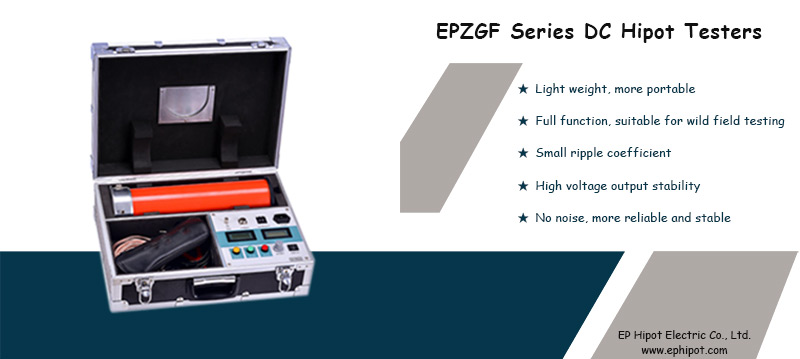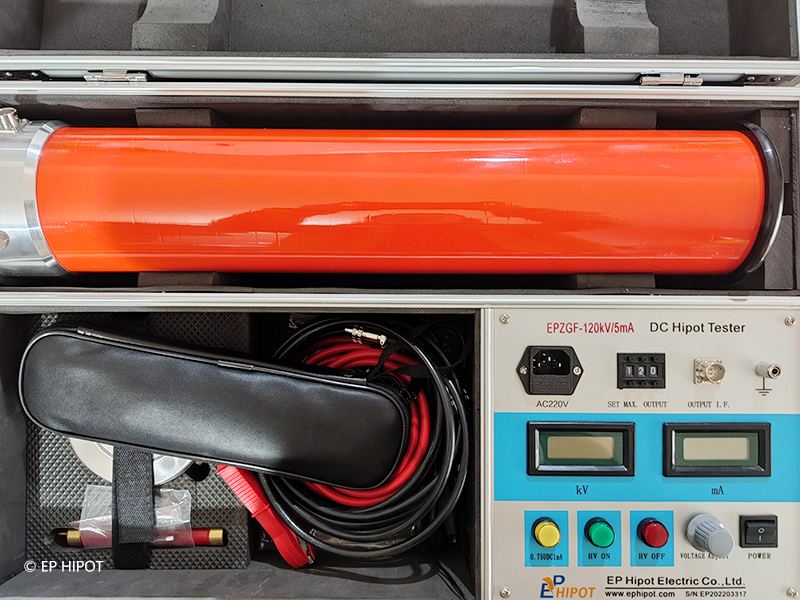- Transformer testing
- High voltage insulation testing
- Circuit breaker test equipment
- CT PT testing and calibrating
- Motor and generator testing
- Oil testing
- SF6 gas testing
- Arrester and insulator testing
- Insulation/Earth Resistance testing
- DC system
- Relay and protection testing
- Cable fault test and diagnostics
- Partial discharge
- Electrician testers
- Battery and power quality
Steps for Using DC Hipot Tester
EP Hipot Electric is a professional manufacturer of DC Hipot Test Equipment. The DC Hipot Tester produced by EP Hipot Electric is widely praised in the industry, and strives to build the most authoritative "DC Hipot Test Equipment" high-voltage equipment supplier.

EP Hipot Electric EPZGF DC high voltage generator adopts new technology, new material and new device, has the characteristics of large output power, small size, light weight, reliable overvoltage, overcurrent and zero closing protection functions, with 0.75 Double voltage latch function, and equipped with time relay, can set timing sound alarm during the test. The whole instrument is easy to carry, easy to operate, safe and reliable, especially suitable for field tests in the power sector.

DC Hipot Tester using steps:
1. Before doing the load test, install the high-voltage shielded microammeter on the high-voltage output end of the pressure multiplier, and connect the matching special high-voltage line to the microammeter and the tested product respectively.
2. Check whether the instrument, discharge rod, booster, test product connecting wire and ground wire are correct, whether the ground wire connection is reliable, and check whether the high-voltage safety distance meets the requirements before starting the high-voltage test of the test product.
3. After checking the DC hipot tester and confirming that there is no abnormality in the instrument, turn on the single-phase AC 220V power switch, and the green light is on at this time, indicating that the power is turned on. The DC leakage and DC withstand voltage test of the sample can be started.
4. Press the red button, the red light will be on, indicating that the high voltage is connected, and the voltage will be raised.
5. Slowly adjust the voltage regulating potentiometer in a clockwise direction, and the output terminal will start to increase the voltage from zero. The boosting speed is appropriate to increase the test voltage at 3-5kV per second. When boosting the voltage of the large-capacitor test product, it needs to boost the voltage slowly, otherwise it may cause voltage overshoot. It is also necessary to monitor the charging current of the ammeter to not exceed the maximum charging current of the DC booster. When the required voltage or current is reached, record the readings of the ammeter and voltmeter according to the specified time.
6. After the test is completed, reduce the voltage and return the voltage regulating potentiometer to zero, then press the green button to cut off the high voltage and turn off the power switch.
7. After the test is completed, discharge the test product several times with a discharge rod, and then approach the test product and remove the stitches after discharge. For small capacitance test samples such as zinc oxide arrester, magnetic blowing arrester, etc., slowly adjust the voltage regulating potentiometer to boost to the required voltage (current) value, and then read the voltage (current) value from the digital display.
When it is necessary to measure 75%VDC-1mA on the zinc oxide arrester, the voltage value should stop when the current reaches 1000uA (the voltage and current value can be recorded at this time), and then press the yellow button, the voltage will drop to the original 75% and keep it that way. At this time, the microammeter value and voltage value can be read. After the measurement is completed, the voltage regulating potentiometer returns to the zero position counterclockwise, press the green button, and press the red button when the voltage needs to be boosted again. For large-capacitor test products, the boosting speed should be slower, and it is necessary to monitor that the charging current of the ammeter does not exceed the maximum charging current of the generator. The boosting speed must be slowed down to avoid excessive charging current. After the test, return the voltage adjustment potentiometer to the zero position counterclockwise, then press the green button to cut off the high voltage, do not turn off the power supply at this time, the voltmeter shows that there is still voltage value, this is the stored voltage, wait until the voltage drops to About 2000V, the discharge rod can be used for multiple discharges to ensure safety. The DC high voltage generator has a variety of protection functions, such as: low voltage overcurrent, low voltage overvoltage, high voltage overcurrent, high voltage overvoltage, zero protection, ungrounded protection, etc. The fault sampling adopts a special sensor, the action time is nanosecond, and the optical isolation element is also nanosecond. The action time is generally 10 microseconds to completely shut down the DC main circuit. The push signal fast shutdown protection adopts special sensor sampling at the output end, and the response time is nanosecond. Through the nanosecond optical isolation element and the nanosecond analog switch, the whole process will convert the push signal of the power amplifier circuit within 2 microseconds. Cut off to ensure that the power device is not damaged in the case of output short circuit.
Related DC high voltage testing equipment introduction:
https://www.ephipot.com/en/hope-10.html

